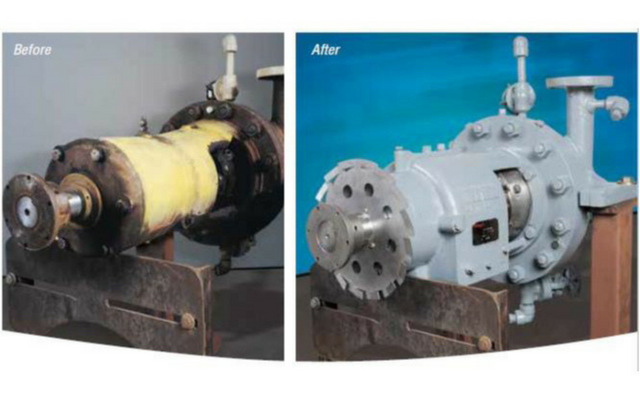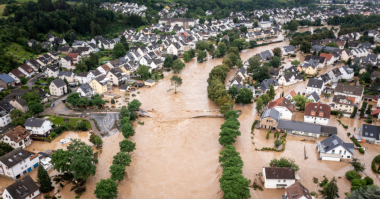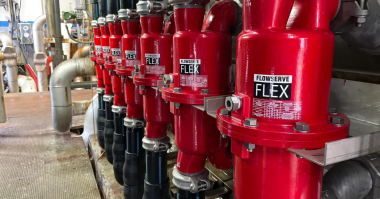The Challenge:
Sonara, a customer operating an oil refinery in Cameroon, Africa, was experiencing significant leakage on their light hydrocarbon (GPL) process pumps while requiring frequent intervention every three months to keep their equipment operating and prevent a more significant outage.
The existing OH2 pumps installed in the catalytic reforming unit were obsolete, they were equipped with single seals, and unfortunately a simple upgrade from a single to dual seal configuration was not possible. This was due to inadequate space available in the pump’s power end and seal chamber area in order to install a dual seal. Despite the recurrent issues, Sonara wanted to avoid replacing the existing pumps with new units equipped with dual seals because they wanted to avoid piping modifications and other costly civil works that would be required to change out the entire pump.
The Solution:
Flowserve introduced the idea of upgrading the existing OH2 pumps with new Flowserve RVX pull-out power end assemblies. The concept was presented to the customer by the Technical Services team, during one of the frequent technical forums arranged at their premises, and quickly gained the customer’s attention as a viable, less costly solution. Flowserve developed the RVX back pull-out assembly upgrade program specifically to address end users’ needs for improved pump reliability and with reduced maintenance and installation costs. The RVX program similarly applies to any existing ISO/API OH1 and OH2 pump installation, regardless of OEM, and assists users in reducing fugitive volatile organic compound (VOC) emissions while gaining the advantages of a bearing frame in full compliance with the latest edition of ISO 13709/API 610.
The RVX solution addressed the challenge by meeting the following customer needs:
- Replaced older technology and obsolete bearing assemblies and seal chambers on the overhung pumps (OH2) with newer API 610 & API 682 latest edition compliant components
- The larger shaft diameter and low deflection Index I = L3/D4 reduced the shaft deflection and the load on mechanical seals, increasing the MTBR and reliability with less chance for the wear rings to rub
- The sealing chamber allowed hosting a dual seal to comply with their insurance requirements and to comply with the latest edition of API 682;
- The newer design reduced the potential for fugitive volatile organic compound (VOC) emissions, improving safety and compliance with legislative changes, e.g. emissions, ATEX, etc.;
- Provided standardization since, regardless of original equipment manufacturer and origin, the new design applies to any existing ISO/API OH1 and OH2 pump installation, and provides standardization around 3 assembly frame sizes only.
Immediately after the technical forum, Sonara invited Flowserve to visit the plant to take a look at the operating pumps and start working on a technical proposal. The proposal was built by the Flowserve Arnage technical service team together with Sonara maintenance and reliability departments based on customer updated data sheets, performance test curves, general arrangement drawings, and the original manufacturer’s data book. Selection and coordination of the suitable RVX size, mechanical seal and flush plan were completed and validated in accordance with Sonara staff.
Sonara decided to pursue modification of the existing pumps with an RVX upgrade together with a Flowserve QBQ/GSL dual mechanical seal and plan 76 seal support system.
The QBQ/GSL dual seal configuration with a GLS dry-running lift-off containment seal allowed for significant reduction of emissions to the atmosphere, and is a common selection for light hydrocarbon applications. The GSL secondary seal is capable of running with liquid, gas, or a combination of both. The configuration of QBQ seal inboard and GSL seal outboard ensures there is very low process leakage (less than 500 ppm leakage without a buffer gas), and is ideally suited for vaporizing products like this particular application.
The plan 76 seal support system is recommended for light hydrocarbon services to vent primary seal leakage to flare or vapor recovery. The system is equipped with a high/low pressure alarm to detect inboard or outboard seal failure and it operates at flare header pressure.
The Result:
Since the start-up of the upgraded pumps in September 2012, the pumps have been running smoothly and leakage issues have not reoccurred. MTBR has been improved significantly from 3 months before upgrade to more than 24 months and Sonara was so satisfied about the Flowserve solution that during the annual African Refinery Association meeting held in Dakar in February 2015, members of their Maintenance Department presented the RVX upgrade as an industry success story.
As a consequence of Sonara’s presentation, other African Refineries are showing increased interest in the Flowserve RVX solution.
This upgrade program is an example of how Flowserve technical solutions can definitively solve customer issues and dramatically improve customer operating performance while reducing cost. It is also an excellent example of the importance of customer satisfaction, and how satisfying customers can generate both direct and indirect benefit to Flowserve.




